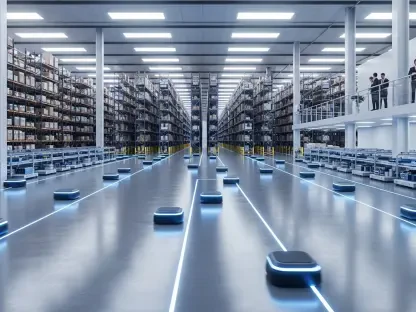In a stunning turn of events, Jaguar Land Rover (JLR), the United Kingdom’s largest automotive manufacturer, suffered a catastrophic cyberattack on August 31, 2025, marking one of the most severe corporate cyber incidents in British history. This breach, attributed to the notorious Scattered Lapsus$ Hunters group, has brought JLR’s global operations to a standstill for over a month, resulting in staggering financial losses estimated in the billions and putting hundreds of thousands of jobs at risk across the supply chain. The incident has not only crippled a cornerstone of British industry but also exposed the alarming vulnerabilities of modern manufacturing in an era increasingly defined by digital interconnectedness. As the fallout continues to unfold, this crisis serves as a stark reminder of the urgent need for robust cybersecurity measures in a world where a single hack can paralyze an industrial giant. The scale of disruption and the cascading effects on the economy have sparked intense scrutiny and debate over how such risks can be mitigated.
Unraveling the Attack and Its Immediate Consequences
The cyberattack on JLR struck with devastating precision on August 31, 2025, when hackers infiltrated the company’s critical IT systems, forcing an immediate and unprecedented response. To prevent further damage, JLR made the drastic decision to shut down its entire global network, halting production at all facilities across the UK, China, Slovakia, India, and Brazil. In the UK, key manufacturing plants in Solihull, Wolverhampton, and Halewood, which collectively produce around 1,000 vehicles each day, have been idle since the breach. This sweeping operational paralysis, though necessary to contain the threat, underscores the deep reliance of modern carmakers on digital infrastructure. A single point of failure in these systems can grind an entire production line to a halt, revealing the fragility that lurks beneath the surface of industrial efficiency. The speed and scope of the shutdown highlight how quickly a cyber incident can escalate into a full-blown crisis for even the most established corporations.
Beyond the initial shutdown, the immediate aftermath of the attack has painted a grim picture of operational chaos for JLR. The perpetrators, identified as part of the Scattered Lapsus$ Hunters group tied to the infamous Scattered Spider syndicate, exploited vulnerabilities that left the company scrambling to secure its systems. While the exact method of infiltration remains under investigation, the impact is undeniable—global operations have been frozen, disrupting not just production but also logistics and customer deliveries. This incident stands as a sobering example of how cyber threats can target and incapacitate critical sectors like automotive manufacturing, where downtime translates directly into massive losses. The inability to resume normal activities in the short term has raised pressing questions about the adequacy of existing cybersecurity protocols and whether such large-scale disruptions could have been anticipated or prevented with stronger defenses in place.
Financial Catastrophe and Oversight in Risk Planning
The financial ramifications of the cyberattack on JLR are nothing short of staggering, with industry estimates placing weekly losses between £50 million and £500 million. If the shutdown persists into November, total losses could soar to an eye-watering £4.7 billion, a figure that threatens to reshape the company’s economic standing. Daily losses are speculated to be as high as £7.1 million, draining resources at an alarming rate. This financial hemorrhage has placed immense pressure on JLR to resolve the crisis swiftly, yet the path to recovery remains fraught with challenges. The scale of these losses illustrates the profound cost of cyber incidents in industries where production is tightly scheduled and margins are often thin. It also serves as a cautionary tale for other corporations about the devastating potential of digital breaches when left unchecked or underestimated in strategic planning.
Compounding the financial distress is the shocking revelation that JLR lacked active cyber insurance at the time of the attack, a decision that has left the company to shoulder the full burden of these astronomical costs. Unlike other major firms that have mitigated similar incidents through comprehensive insurance policies, JLR’s oversight in this area has amplified the economic damage. This gap in risk management raises critical questions about how such a significant player in the automotive sector could overlook a safeguard that has become increasingly standard in a digital age rife with threats. The absence of a financial safety net means that every pound lost comes directly from the company’s reserves, potentially jeopardizing future investments and long-term stability. This situation emphasizes the urgent need for corporations to integrate cybersecurity insurance into their broader risk strategies, treating it as an essential shield against the unpredictable nature of cybercrime.
Human Toll and Wider Economic Disruption
The impact of JLR’s operational shutdown extends far beyond corporate ledgers, striking at the livelihoods of countless individuals tied to the UK’s largest automotive supply chain. JLR directly employs 30,000 workers and supports an estimated 120,000 to 200,000 additional jobs through hundreds of supplier companies, many of which are small and medium-sized enterprises dependent on consistent orders. The production halt has triggered widespread economic hardship, with reports indicating that one in six businesses in the supply chain has already resorted to layoffs. Others have shifted workers to precarious zero-hour contracts, slashing incomes overnight. The human cost of this crisis is palpable, as families and communities grapple with sudden uncertainty, revealing how deeply a single corporate disruption can reverberate through an interconnected economy.
Further illustrating the scale of distress, specific cases of smaller suppliers highlight the devastating ripple effects of JLR’s paralysis. One such company was forced to lay off nearly half its workforce—40 employees—due to the abrupt loss of business, a move that underscores the vulnerability of smaller players in the automotive ecosystem. These suppliers, often lacking the financial buffers of larger corporations, face existential threats when a major client like JLR grinds to a halt. The cascading impact exposes the fragility of an industry where interdependency is both a strength and a liability. Beyond the immediate job losses, the broader economic fallout threatens regional economies across the UK, where automotive manufacturing serves as a cornerstone of employment and growth. This crisis serves as a stark reminder that cyberattacks are not just technical failures but societal challenges with profound human consequences.
Navigating Recovery Amid National Intervention
JLR’s approach to recovery has been deliberately cautious, prioritizing the security of its IT systems over a hasty return to production. In collaboration with cybersecurity experts and the UK’s National Cyber Security Centre, the company is working to ensure that vulnerabilities are addressed before operations resume. The Wolverhampton engine facility is slated to restart on October 6, with other plants following in phased stages over subsequent weeks. However, industry analysts warn that achieving full production capacity could take an additional three to four weeks, pushing a complete recovery well into the later months of the year. This methodical strategy, while aimed at preventing further breaches, reflects the complexity of restoring trust and functionality in systems compromised on such a massive scale. The prolonged timeline also signals the depth of damage inflicted by the attack and the challenges of rebuilding in a high-stakes environment.
In an extraordinary response to the crisis, the UK government has intervened with a £1.5 billion emergency loan, underwritten to protect JLR’s pivotal role in the national economy. Facilitated through commercial banks but backed by state guarantees, this financial lifeline—set to be repaid over five years—marks a historic precedent as the first direct support of its kind for a cyberattack-related corporate crisis. This bold move underscores the strategic importance of JLR as a flagship of British manufacturing and highlights the growing recognition of cyber threats as national security concerns. Government involvement also reflects the broader economic stakes, as the potential collapse or prolonged distress of JLR could destabilize entire sectors and regions. While this intervention offers a critical buffer, it also raises questions about the role of public funds in private sector failures and whether such measures will become more common as digital risks escalate.
Critical Lessons for Industrial Cybersecurity
The cyberattack on JLR stands as a harrowing wake-up call for British industry, exposing the acute vulnerability of modern manufacturing to digital threats. A single breach in an IT system can halt a multi-billion-pound production line, demonstrating the inseparable link between digital infrastructure and physical operations. This incident reveals how reliance on technology, while driving efficiency, can become a double-edged sword when adequate defenses are not in place. The interconnectedness of the automotive sector amplifies the fallout, as disruptions to a key player like JLR ripple through suppliers, distributors, and ancillary businesses. Industry observers note that this crisis must prompt a fundamental shift in how manufacturers view cybersecurity, moving it from a peripheral IT concern to a central pillar of operational strategy. Without such a change, similar catastrophes loom on the horizon for other sectors equally dependent on digital systems.
Another crucial lesson from JLR’s ordeal is the glaring need for comprehensive risk management, including cyber insurance, as a non-negotiable component of business resilience. The absence of such coverage has left JLR exposed to crippling financial losses, a misstep that other companies must avoid. Beyond insurance, the incident highlights the importance of proactive investment in robust cybersecurity frameworks, regular system audits, and employee training to mitigate risks before they escalate into crises. The cascading effects on the supply chain further emphasize that preparedness must extend beyond individual corporations to encompass entire ecosystems. As digital threats grow in sophistication, British industry faces a clear imperative to prioritize cybersecurity with the same rigor applied to production and innovation. Only through such a holistic approach can manufacturers hope to safeguard their operations and the livelihoods tied to them against future digital assaults.
Path Forward After Unprecedented Disruption
Reflecting on the events following August 31, 2025, the cyberattack on JLR emerged as a defining moment that tested the resilience of British manufacturing. The operational shutdown, immense financial losses, and widespread human impact painted a sobering picture of the consequences of digital vulnerabilities. Government intervention with a historic emergency loan provided a lifeline, while JLR’s cautious recovery efforts aimed to rebuild securely. Yet, the prolonged timeline to full restoration underscored the depth of the damage inflicted. This crisis exposed critical gaps in preparedness that had been overlooked, leaving an indelible mark on the company and its vast network of suppliers. The lessons learned from this incident became a catalyst for introspection across industries, highlighting the urgent need for systemic change in how cyber risks are addressed. Moving forward, the focus shifted to actionable strategies—strengthening defenses, securing financial safeguards like insurance, and fostering collaboration across supply chains—to ensure that such a devastating blow would not be repeated in the future.









